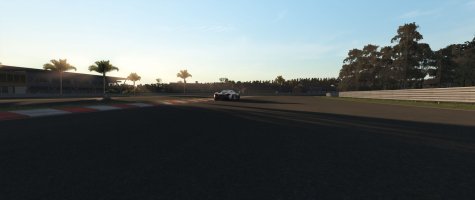So that would mean: you type in the angle you want for the field of view, and it maps it onto an arc that subtends that angle at the virtual "camera"/eyeball. Is that not how it works in reality?
That would be the idea, yep!
But right now it works like this (Screenshots from some nvidia demo):
That's the standard viewport rendering. The FOV setting is how far the projection point at the bottom of the picture is away from the monitor and determines the angle.
With a curved monitor like these 49" 32:9, you take what you see in the picture and make it curved. So the projection is pretty wrong...
ACC has a setting for this btw! But it only bends the final frame, so the center becomes blurry/pixelated if going too far.
It looks quite disturbing when changing between different games/sims...
For triples, it looks like this without the adjusted rendering:
And like this when it gets corrected/split into 3 viewports:
And for curved monitors, you'd need to draw the projection lines to a curved viewport, which would be quite different and probably isn't easy to change in the engines

These are from this video about VR projection btw:
I've never used an ultrawide screen or indeed a curved one, and I don't like driving with a postage-stamp view so as a result I have never experienced a game FOV angle that was remotely similar to the physical angle subtended by my screen at my eyeballs...
Yeah me neither! I'm using 49° FOV on my 34" 21:9 (27" height) at 80cm distance.
"Correct" FOV would be 24°!!!
I seem to be a special snowflake as my eyes start to hurt when going below 40°. And I get super dizzy when going above 50°.
There's a little sweetspot where it feels natural for me. I hate games without an FOV settings and a (for me) wrong FOV.
For some reason Battlefield defaults to something like 38° fov, Rocket League to 60°, lol.










